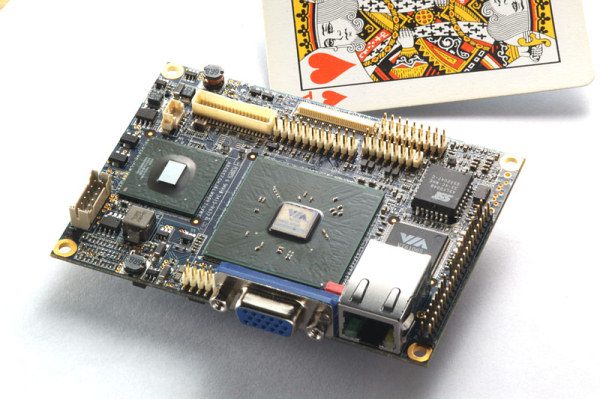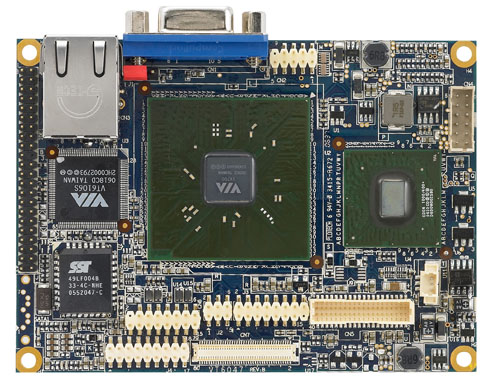 |
||
|
||
| ||
New Matrox DualHead2Go Digital Edition Now Shipping NEC Develops First Color LCD With Embedded DRAM Frame-Memory System VIA Announces Pico-ITX Mainboard Super Talent Announces 1333MHz DDR3 Memory New Matrox DualHead2Go Digital Edition Now Shipping
DualHead2Go Digital Edition has a manufacturer’s suggested retail price of $229USD. This product is available from authorized resellers worldwide or, in North America and Europe, directly from Matrox at http://shopmatrox.com. Source: Matrox Graphics
NEC Develops First Color LCD With Embedded DRAM Frame-Memory System NEC LCD Technologies announced development of the world's first thin-film-transistor liquid crystal display prototype module with a DRAM frame memory system, corresponding to 18-bit color (262k colors), embedded onto the glass substrate of the LCD screen. The results of this research are presented on May 24 at SID 2007 at the Long Beach Convention Center in California. The new LCD module has been realized by a combination of NEC LCD Technologies' own value integrated TFT-LCD (VIT) technology and low-temperature poly-silicon (LTPS) TFT technology, and includes the following key features. 
Currently, graphics frame memory is realized by a COG-mounting method that attaches system-LSI chips, made on a silicon substrate, directly onto the glass substrate of the LCD. However, this poses a problem for timely manufacturing of new LCD modules as the lead time for mass production of system LSI chips is very long. Through further development of its VIT technology to integrate peripheral circuits necessary for LCD image display, NEC LCD Technologies aims to realize a Zero Chip Display, which would enable direct connection to the MPU bus line of the system. Source: NEC LCD Technologies
VIA Announces Pico-ITX Mainboard VIA Technologies announced the VIA EPIA PX mainboard, the first commercial mainboard based on VIA's recently unveiled Pico-ITX form factor measuring just 10cm x 7.2cm. Powered by the 1GHz VIA C7 processor and supporting up to 1GB of DDR2 533 SO-DIMM system memory, the tiny 10-layer VIA EPIA PX mainboard is based around the single-chip VIA VX700 system media processor, which features the VIA UniChrome Pro II IGP 3D/2D graphics core, MPEG-2/-4 and WMV9 hardware decoding acceleration and display flexibility, including support for higher display resolutions of up to HDTV for HD DVD playback.  Onboard connectors and I/O enable developers to harness the full power of the mainboard, though the VIA PX-O, a dedicated daughterboard with multiple digital media I/O ports, is available on request to assist project developers in early system testing. Power efficiency is integral to the platform, with the maximum power (TDP) of the processor and chipset at 9W and 3.5W respectively combined with low power DDR2 memory enabling the VIA EPIA PX to run standard productivity and multimedia applications at under 13W.  This scale of platform miniaturization has been made possible only by the reduction in size of the core silicon; the 21mm square nanoBGA2 package of the VIA C7 processor and 35mm square VIA VX700 system media processor have a combined area of just 16.7cm2, a board real estate saving of over 50% from previous generation EBGA processors plus twin-chip core logic solutions, and more than that over competing solutions.  Specifications:
The VIA EPIA PX mainboard is available now for developers, and will be available in limited quantities through authorized distributors in late May. Source: VIA Technologies
Super Talent Announces 1333MHz DDR3 Memory Super Talent Technology announced a new line of extreme performance 1333MHz and 1066MHz DDR3 modules. These JEDEC compliant 1GB modules and 2GB kits were designed specifically for the new Intel P35 “Bearlake” platform, and have already been validated on multiple P35 motherboards. These modules are clad in Super Talent’s custom black cast aluminum HE heat spreaders for improved thermal performance. 
These DDR3 products are designed, built and tested in Super Talent’s San Jose, California headquarters. Every Super Talent module built is hand tested in a motherboard under load to ensure the reliability. These products are all sampling now, and will be shipping in volume in June. W1066UX2G7 is expected to retail for approximately $489. Source: Super Talent Technology
Write a comment below. No registration needed!
|
Platform · Video · Multimedia · Mobile · Other || About us & Privacy policy · Twitter · Facebook Copyright © Byrds Research & Publishing, Ltd., 1997–2011. All rights reserved. |